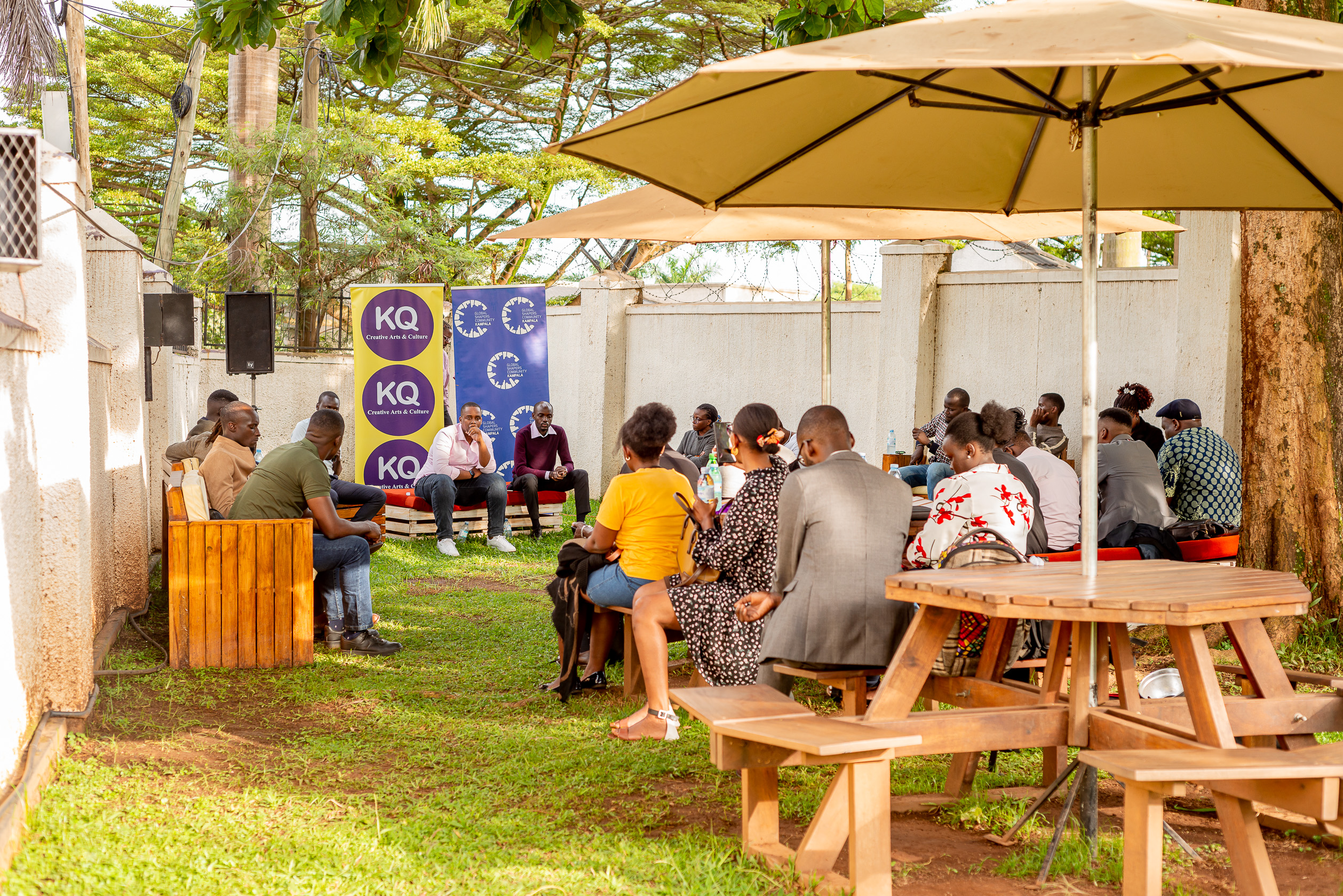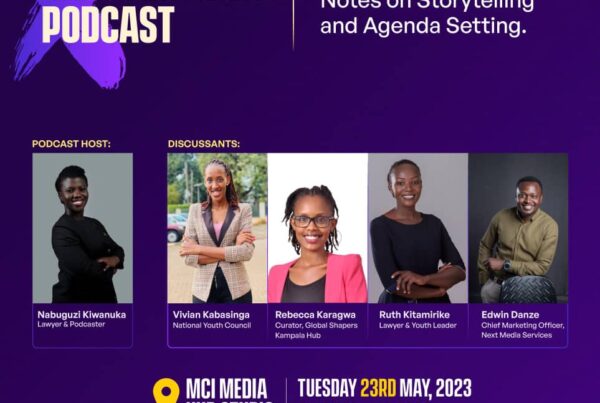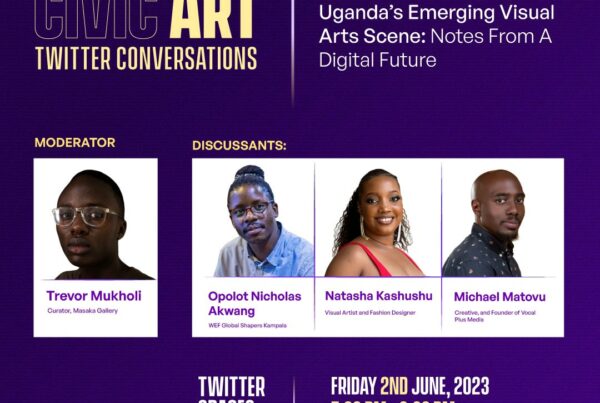In collaboration with key stakeholders in the creative arts and civic space, KQ Hub Africa curated the #Civic Art Talks series to delve into the intersection of participatory arts and transitional justice. The objective was to amplify the work of other transitional justice mechanisms in Uganda, promote community participation, provide context on creative agency, and reinforce respect for human rights through memory and restorative practices.
On 23rd June, the Sankara Pan African Library served as the venue for an insightful and thought-provoking dialogue. Joshua Mahande, a Legal Officer from the Foundation for Human Rights Initiative, skillfully moderated the event, guiding the conversation toward interrogating the limitations faced by transitional justice mechanisms in achieving inclusion, reconciliation, and civic agency.
The panel of esteemed discussants included Nshuti Zirimwagabo, Program Administrator for Development Cooperation at the Embassy of Sweden; Rushongoza Begumya, an Author, Poet, and Lawyer; Bonita Nyamwire, Director of Research at Policy; and Eric Diogo, a Protection Officer at Caritas. Together, they explored the potential of the arts as a bridge connecting normative legal standards with reconciliatory aspirations, emphasizing the creative process as integral to building peace.
Across the East African region, we witness the remarkable rise of participatory arts, taking center stage in preserving memory and fostering reconciliatory processes. A compelling example is the Kigali Genocide Memorial, inaugurated in 2004 as the final resting place for over 500,000 victims of the Genocide against the Tutsi. This memorial not only pays homage to the lives lost but also educates visitors about the atrocities committed and examines genocide in the 20th century. The emergence of participatory arts as a powerful medium for addressing the shortfalls of transitional justice is a significant development in Uganda and across the East African region. In the wake of violent conflicts and mass atrocities, communities are faced with immense challenges in achieving reconciliation and healing. Traditional methods of transitional justice, such as legal mechanisms and truth commissions, have limitations in fully engaging communities and ensuring their active participation in the process.
Participatory arts, on the other hand, offer a fresh approach that bridges the gap between normative legal standards and the aspirations of reconciliation. This innovative form of artistic expression encompasses a wide range of practices, allowing individuals to actively participate and contribute to the narrative of their own experiences. From large public art initiatives to small-scale workshops, participatory arts create spaces for dialogue, remembrance, and healing that are accessible and inclusive.
One of the key strengths of participatory arts lies in its ability to give a voice to marginalized and affected communities. Through various art forms such as fine art, photography, film, theatre, dance, music, embodied practice, and traditional crafts, individuals can share their stories, express their emotions, and engage in collective storytelling. This process of artistic expression not only fosters individual healing but also promotes empathy and understanding among different groups, ultimately leading to a greater sense of community and social cohesion. Moreover, participatory arts serve as a catalyst for community-based rehabilitation programs. They empower individuals to reclaim their agency and actively participate in shaping their own narratives. By involving communities in the artistic process, participatory arts create a sense of ownership, enabling individuals to contribute to the broader transitional justice agenda and influence its outcomes. This bottom-up approach ensures that the needs, perspectives, and aspirations of affected communities are central to the process, leading to more inclusive and sustainable solutions.
Participatory arts encompass a wide range of practices, from large-scale public art initiatives to intimate, small-scale workshops. This inclusive approach embraces various art forms, including fine art, photography, film, theatre, dance, music, embodied practice, and traditional crafts. By adopting participatory arts as an alternative, communities can harness its transformative potential to achieve social justice, offering individuals a platform to express their experiences, heal wounds, and engage in collaborative storytelling. Participatory arts place communities at the center of the creative process, empowering individuals to actively shape their narratives and reclaim their agency. By involving community members in artistic activities, such as storytelling, theater performances, or mural painting, participatory arts foster a sense of ownership and collective responsibility. This active engagement enables communities to assert their identities, express their aspirations, and contribute to the process of healing and reconciliation.
Traditional approaches to transitional justice often focus solely on legal mechanisms and punitive measures. Participatory arts offer an alternative lens through which justice can be reimagined. By integrating artistic practices into the transitional justice framework, a broader understanding of justice emerges—one that encompasses healing, empathy, and transformation. Participatory arts enable communities to explore new possibilities for justice that go beyond retributive measures and encompass restorative and transformative elements. Participatory arts provide safe and inclusive spaces for dialogue, enabling individuals from diverse backgrounds to come together, share their experiences, and listen to one another. Through artistic collaborations and workshops, participants engage in open conversations that facilitate understanding, empathy, and the recognition of shared humanity. These safe spaces foster trust, encourage difficult conversations, and promote reconciliation, laying the groundwork for long-lasting social change.
In post-conflict societies, engaging youth is crucial for sustainable peace and justice. Participatory arts provide a means to involve young people actively in transitional justice processes, fostering their sense of responsibility and ownership in shaping the future. By nurturing creativity, critical thinking, and empathy, participatory arts empower youth to become agents of change, challenging cycles of violence and building a more inclusive and just society. Throughout the event, insights from a Ugandan perspective enriched the dialogue, reminding attendees of the unique challenges faced by their country and the importance of addressing the wounds inflicted by years of conflict. The stories shared, the emotions evoked, and the experiences recounted by survivors emphasized the urgent need for healing, reconciliation, and the meaningful inclusion of all stakeholders in the transitional justice process.
In Uganda, where the scars of war and conflict are still healing, participatory arts have gained traction as a means to address the complex challenges of transitional justice. Artists of all disciplines are working within communities, cultural centers, and refugee camps, using their creative skills to build resilience and peace from the grassroots level. These artistic interventions provide spaces for reflection, dialogue, and understanding, allowing individuals to process their trauma, mourn their losses, and find solace in shared experiences. Insights from a Ugandan perspective provide a unique and crucial understanding of the potential of participatory arts in transitional justice. Through addressing Local Realities, Transitional justice efforts must be rooted in the local realities and specific needs of affected communities. Insights from Ugandan perspectives highlight the importance of tailoring participatory arts initiatives to address the unique challenges faced by different regions, ethnic groups, and communities within the country. Understanding the historical, social, and cultural contexts enables the design of artistic interventions that resonate with local experiences and contribute to more meaningful and sustainable outcomes
The adoption of participatory arts as an alternative approach to transitional justice in Uganda holds immense promise. It not only offers a pathway for healing and reconciliation but also contributes to the broader goals of social justice, human rights, and community empowerment. By recognizing the transformative power of art and its ability to foster empathy, understanding, and dialogue, Uganda is embracing a more holistic and inclusive approach to transitional justice, one that acknowledges the vital role of the arts in shaping a brighter and more reconciled future.
Transitional periods are fraught with questions of justice, necessitating a delicate balance between redistribution, recognition, and the ongoing pursuit of fairness. While governments and institutions often dominate the overt peacebuilding process, artists of all disciplines work tirelessly behind the scenes, operating within communities, cultural centers, refugee camps, and war zones. Through their engaging forms and processes, they contribute to framing conflict narratives, preserving memory, providing avenues for meaningful mourning, and fostering empathy for the suffering of others.
The role of arts in transitional justice goes beyond providing a platform for individual expression and healing. It encompasses a range of crucial functions that contribute to the overall process of reconciliation, memory, and societal transformation. For example; Amplifying Marginalized Voices: Transitional justice processes often focus on prominent narratives and voices, leaving marginalized individuals and communities unheard. Arts provide a space where these voices can be amplified and centered, allowing for a more inclusive and comprehensive understanding of the conflict’s impact. By engaging marginalized groups through artistic expression, their experiences, and perspectives can be brought to the forefront, challenging dominant narratives and fostering a more accurate and nuanced collective memory. Challenging Denial and Promoting Truth-telling: Arts have the power to challenge denial and expose hidden truths. Through various artistic mediums, including visual arts, theater, and literature, artists can convey the realities of past atrocities, creating a shared understanding of the injustices committed. By giving visibility to the victims’ experiences and raising awareness among the broader society, arts play a crucial role in countering narratives of denial, distortion, and historical revisionism. Building Empathy and Bridging Divides: Transitional justice aims to bridge divides and foster reconciliation among communities. Arts have a unique ability to cultivate empathy and facilitate dialogue between individuals from different backgrounds. Whether through theater performances, community art projects, or collaborative storytelling, arts enable people to engage with diverse perspectives and experiences. This empathetic engagement is essential for breaking down stereotypes, fostering understanding, and building bridges between divided communities. Healing and Trauma Recovery: Artistic expression can provide a powerful avenue for healing and trauma recovery. Creating and engaging with art can help individuals process their emotions, explore their identities, and find catharsis. Art therapy and participatory workshops can support survivors and communities in their healing journey, offering a safe space for self-expression, introspection, and resilience-building. By addressing the psychological and emotional wounds caused by conflict, arts contribute to individual and collective well-being. Fostering Dialogue and Reconciliation: Transitional justice processes often involve structured dialogues between victims, perpetrators, and the broader community. Arts-based initiatives provide alternative and creative spaces for dialogue and reconciliation. Collaborative art projects, community murals, and interactive performances offer opportunities for people to come together, share their stories, and find common ground. These artistic interventions promote a culture of empathy, understanding, and forgiveness, paving the way for sustainable reconciliation and social cohesion. Shaping Collective Memory: Arts shape and preserve collective memory by creating tangible and symbolic representations of the past. Memorials, museums, and public art installations serve as reminders of the atrocities committed, honoring the victims and educating future generations. Through artistic mediums, historical narratives can be visualized, making the memory of the conflict more accessible and engaging for wider audiences. By shaping collective memory, arts contribute to the prevention of future violence and the cultivation of a shared commitment to human rights and social justice.
The dialogue also highlighted the importance of homegrown solutions in addressing the issues of transitional justice cannot be overstated. Insights from a Ugandan perspective highlight the need for local actors to take a leading role in shaping the processes and initiatives aimed at healing and reconciliation. While international actors and organizations play a valuable role in providing support and resources, it is crucial to ensure that local voices and perspectives take center stage.
In the case of Uganda, advocating for homegrown solutions is particularly significant in light of the successes witnessed in neighboring Rwanda and Northern Uganda. Rwanda’s post-genocide journey toward healing and reconciliation is often cited as a powerful example of a locally-driven transitional justice process. The Gacaca courts, for instance, were community-based tribunals that played a pivotal role in addressing the immense challenges faced by the country. This approach ensured that the process of justice was grounded in the cultural context, values, and traditions of the Rwandan people, ultimately leading to a sense of ownership and legitimacy.
Similarly, in Northern Uganda, the Acholi people have embraced their traditional mechanisms of justice and reconciliation, such as Mato Oput. This indigenous approach, rooted in their cultural heritage, has allowed communities to come together, address grievances, and seek communal healing. By incorporating their own practices and institutions, the Acholi people have been able to rebuild trust and foster social cohesion within their communities.
Advocating for homegrown solutions in transitional justice acknowledges the agency, knowledge, and wisdom of local communities. It recognizes the importance of cultural context, historical realities, and community-driven processes in achieving lasting peace and reconciliation. Local actors, such as community leaders, traditional authorities, and grassroots organizations, have a deep understanding of the specific challenges faced by their communities and can provide context-specific solutions that resonate with the needs and aspirations of the people.
To ensure the effectiveness of homegrown solutions, it is important to create spaces for dialogue and collaboration between local actors, international actors, and civil society organizations. By promoting meaningful partnerships and mutual respect, a collective effort can be fostered to address the complex issues of transitional justice. International actors can provide valuable expertise, resources, and technical support, while local actors can contribute their deep knowledge of the context, cultural practices, and community dynamics.
It is also crucial to point out the role of the state and the responsibility of the community in bringing about social change and transitional justice. While the state plays a significant role as a political actor in facilitating transitional justice processes, it is indeed the collective responsibility of society to actively engage in promoting reconciliation and social transformation. In this regard, art can serve as a powerful tool to foster dialogue, disarm tensions, and initiate conversations necessary for reconciliation. Art, in its various forms, has the ability to record the stories and experiences of individuals and communities affected by conflict. It serves as a medium through which collective memory can be preserved and shared. By capturing the human experience, art creates a bridge between the past and the present, enabling reflection on the causes and consequences of violence. Through artistic expression, communities can confront their history, acknowledge the pain and suffering, and foster empathy among different groups. Moreover, art has the unique ability to awaken the conscience of both artists and audiences. It acts as a mirror that reflects the realities of society and challenges the status quo. Artists, through their creative endeavors, have the power to question, critique, and inspire change. By highlighting social injustices and human rights abuses, art can serve as a catalyst for awakening collective consciousness and promoting social transformation.
However, the challenge lies in ensuring that the conscience of art is awakened and that artistic expressions actively contribute to the goals of transitional justice. This requires a supportive environment where freedom of expression is protected, artists are encouraged to explore sensitive and difficult topics, and their works are given platforms for dissemination and engagement. The state, as a political actor, plays a crucial role in creating such an environment by safeguarding artistic freedom and providing resources and infrastructure for artistic initiatives. Additionally, it is important for communities and civil society organizations to actively engage with art as a means of reconciliation. This can be achieved through supporting and attending artistic events, organizing community-based art projects, and providing platforms for dialogue and reflection. By actively participating in and embracing art as a tool for reconciliation, communities take ownership of the healing process and contribute to shaping a more inclusive and just society.
while the state has a responsibility to facilitate transitional justice processes, it is the collective responsibility of society to actively engage in bringing about social change. Art, with its ability to record, disarm, and trigger conversations, plays a crucial role in promoting reconciliation. By awakening the conscience of art and creating an enabling environment for artistic expression, society can harness the transformative power of art to address the legacies of conflict and build a more just and inclusive future.



